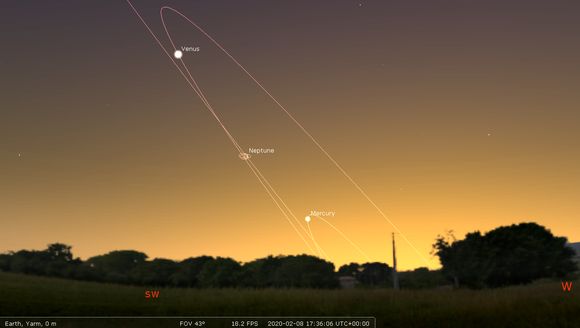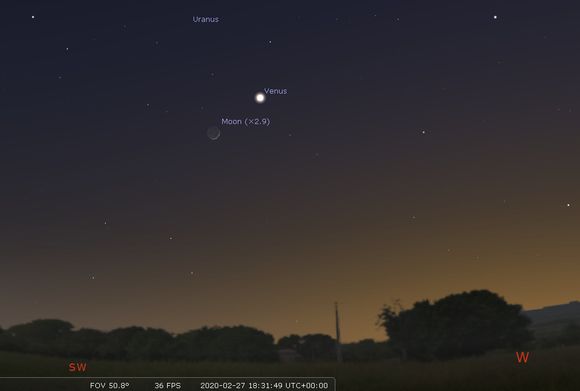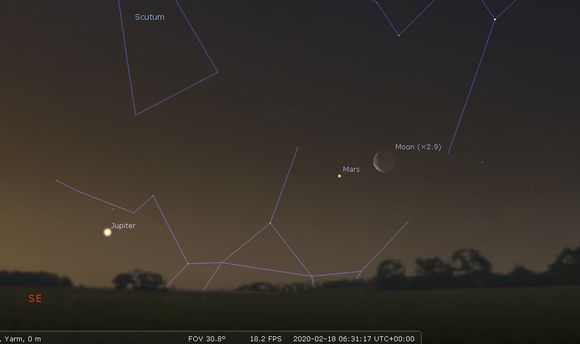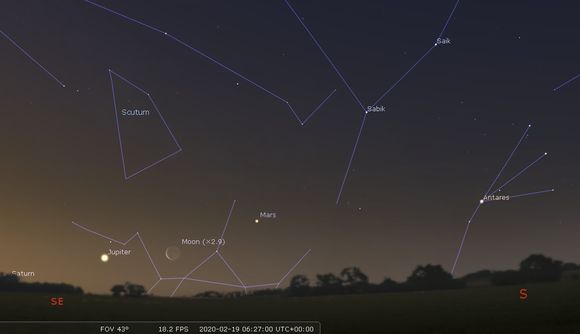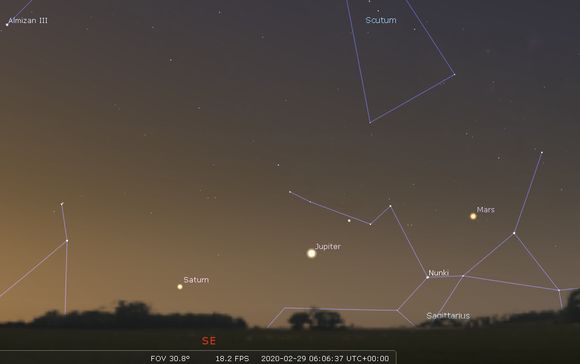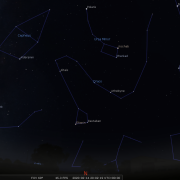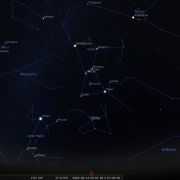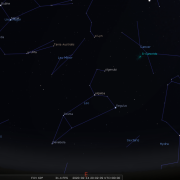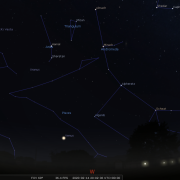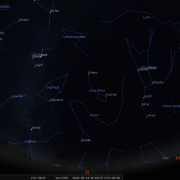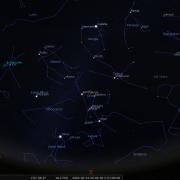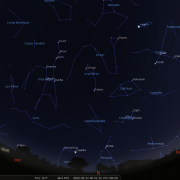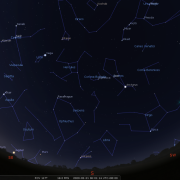In this month's Sky Notes:
Planetary Skylights
Evening Planets

At magnitude -4.3 Venus completely dominates the evening sky over in the west, so much so even the most casual of observers cannot fail to notice it.
Over the course of the month Venus continues to track up through the descending autumn constellations of Aquarius and Pisces and is visible still after 21:00h by the month’s end. Through the telescope there is little to write home about; the surface invisible under the duvet of cloud, however occasionally some vague cloud markings can be seen and the use of a filter, orange or red (either Wratten 21 or 23a or 25 and 29) will help with this. You will notice the phase. A good tip is view Venus in bright twilight, when it’s far less glary to the eye. The crescent moon pays Venus a visit on the 27th.
08-Feb-2020 at 17:30h (WSW): Apparition Paths for Venus and Mercury in the Evening Sky.
(Click for full-sized image)
 Venus is certainly the brightest planet visible; however it is the other inferior planet (Mercury) which should be considered the planetary highlight of the month. (An inferior planet is one which orbits the sun closer than the earth, i.e. Venus or Mercury) Arcing up, low above the WSW–W horizon, before departing again after mid month, Mercury has its best evening apparition of the year.
Venus is certainly the brightest planet visible; however it is the other inferior planet (Mercury) which should be considered the planetary highlight of the month. (An inferior planet is one which orbits the sun closer than the earth, i.e. Venus or Mercury) Arcing up, low above the WSW–W horizon, before departing again after mid month, Mercury has its best evening apparition of the year.
At Mag -1.1 the innermost planet will be brightest at the start of the month, but lower down, so perhaps Feb 3-8th is the optimum observing window. View towards the WSW (lower right of Venus) compass bearing 235-240 degrees around 30-40 minutes after sunset (17:20-17:40) scanning above the horizon approximately 6 degrees. Look for a fairly bright ‘star’ low in the twilight. If it does elude your eyes, use binoculars to help spot it. Mercury reaches greatest elongation east of the Sun on Feb 10th but has faded slightly (-0.7).
Telescopically there is not a great deal to view, but you may notice the phase of around 51 percent; roughly a ‘first quarter’. The low altitude also usually makes for unsteady seeing, but it’s worth tracking down the messenger of the gods, the most elusive of the five naked eye planets
 Uranus resides in Aries, which is slipping down towards the west, but still well placed high to the SW as twilight falls. Although technically visible to the naked eye at mag +5.9, in reality binoculars, or better still, a telescope are required to spot it. Uranus resides just within the borders of Aries quite some distance below the ‘crooked line’ asterism of the Ram. If you have a constellation chart or App etc, use Mesarthim and iota Aries as pointers to locate Uranus, which resides roughly 3 times the distance between these stars and a tad to the right, below them. Through a telescope Uranus resembles a very small disk of subtle grey/green hue.
Uranus resides in Aries, which is slipping down towards the west, but still well placed high to the SW as twilight falls. Although technically visible to the naked eye at mag +5.9, in reality binoculars, or better still, a telescope are required to spot it. Uranus resides just within the borders of Aries quite some distance below the ‘crooked line’ asterism of the Ram. If you have a constellation chart or App etc, use Mesarthim and iota Aries as pointers to locate Uranus, which resides roughly 3 times the distance between these stars and a tad to the right, below them. Through a telescope Uranus resembles a very small disk of subtle grey/green hue.
 Neptune is technically visible although by mid February is lost in solar glare, so we won’t dwell on it until it returns later in the spring.
Neptune is technically visible although by mid February is lost in solar glare, so we won’t dwell on it until it returns later in the spring.
Dawn Planets
Until recently the solitary dawn planet; Mars is joined by Jupiter and Saturn in February, with the crescent moon passing by each of them in turn later in the month.

 At Mag + 1.3 Mars is certainly not the conspicuous object it will eventually become later in the year and is currently only as bright as an average first magnitude star. February commences with Mars low in the SSE, upper left of Antares, ‘the rival of Mars’ and chief star in Scorpius.
At Mag + 1.3 Mars is certainly not the conspicuous object it will eventually become later in the year and is currently only as bright as an average first magnitude star. February commences with Mars low in the SSE, upper left of Antares, ‘the rival of Mars’ and chief star in Scorpius.
Antares actually appears brighter and is of a similar deep amber hue to Mars, confusing the unwary who perhaps think it is Mars! Careful observations over the course of the month will reveal the real Mars however, as it moves relatively quickly against the background stars of Ophuichus and above the ‘teapot’ asterism of Sagittarius. View around 06:15h. For the time being telescope observations of the red planet will be somewhat disappointing, the as yet tiny disk distorted in turbulent air. It will be several months before this starts change. A waning crescent resides right of Mars on the 18th.
Jupiter has returned to the morning sky, emerging from the glare of the Sun and edging up into the eastern twilight sky. Jupiter appears considerably more prominent (Mag -1.9) than Mars and should be readily identified with the naked eye low to the horizon. Jupiter’s disk size in the eyepiece far exceeds that of Mars (even when Mars is at a close opposition) but the low altitude will again make it a tricky object to view satisfactory through a telescope. The ‘dance’ of the Galilean moons is however always fascinating viewing over time. The Moon lies to the right on the 19th.
 Saturn also emerges into the dawn sky after the first week of February, visible just above the SE horizon to the left of Jupiter around 06:45h. At Mag +0.5) the pearly hue of Saturn is not as bright as Jupiter, but brighter than Mars. The rings will be apparent in a telescope, but better observing days await later in the year. The moon lies lower right on the morning of the 20th.
Saturn also emerges into the dawn sky after the first week of February, visible just above the SE horizon to the left of Jupiter around 06:45h. At Mag +0.5) the pearly hue of Saturn is not as bright as Jupiter, but brighter than Mars. The rings will be apparent in a telescope, but better observing days await later in the year. The moon lies lower right on the morning of the 20th.
Meteors

There is just one minor meteor shower this month, the Alpha Aurigids. The peak (if you can call it that) falls between Feb 6 - 9th. The Zenith Hourly Rate only reaches sporadic levels, barely half a dozen per hour, but if you do spot a meteor heading away from the direction of the zenith, (overhead) where the constellation of Auriga resides at this time of year, it is likely to be an Aurigid!
|
Looking North
Mid-February - 20:00h |
Looking South |
|
Looking East
Mid-February - 20:00h |
Looking West
Mid-February - 20:00h |
|
Northern Aspect
Mid-February - 20:00h |
Southern Aspect
Mid-February - 20:00h |
|
Looking North (Early)
Mid-February - 06:00h |
Looking South (Early)
Mid-February - 06:00h |
Additional Image Credits:
- Planets and Comets where not otherwise mentioned: NASA
- Sky Charts: Stellarium Software
- Log in to post comments

